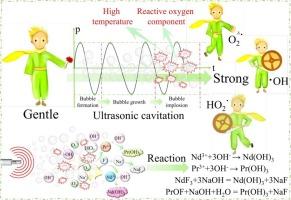Recovery of rare earths from rare earth molten salt electrolytic slag using atmospheric pressure alkaline leaching enhanced by ultrasonic
IF 5
2区 工程技术
Q1 ENGINEERING, CHEMICAL
引用次数: 0
Abstract
Rare earth molten salt electrolytic slag (RMES) contains abundant rare earth elements (REEs) and is a valuable secondary resource. However, conventional approaches to recovering REEs from RMES are hindered by high energy consumption, environmental pollution, and lengthy processing times. This study presents an ultrasonic enhanced (USE) atmospheric pressure alkaline leaching process, which integrates ultrasonic cavitation with concentrated NaOH to realize efficient phase reconstruction of fluorinated rare earth compounds. Under optimized conditions (60 wt% NaOH initial concentration, NaOH-to-slag mass ratio of 3:1, reaction temperature of 130 °C, ultrasonic power of 1440 W, reaction time of 70 min, and stirring speed of 100 r/min), the leaching recovery of neodymium (Nd) and praseodymium (Pr) reached 96.22 % and 95.21 %, respectively, representing a 60 % improvement compared to conventional heating (COH) process. Mechanistic analysis shows that ultrasound helps reduce particle size, increase local reaction temperature (up to 172 °C), and generate reactive oxygen components. These effects collectively accelerate the conversion of fluorinated rare earth compounds (NdF3, PrOF) to hydroxides (Nd(OH)3, Pr(OH)3). This method can eliminate the emission of toxic gases (HF) and reduce energy input, providing a green and efficient approach for recovering rare earth elements from secondary resources.

超声波强化常压碱浸从稀土熔盐电解渣中回收稀土
稀土熔盐电解渣中含有丰富的稀土元素,是一种有价值的二次资源。然而,从RMES中回收稀土的传统方法受到高能耗、环境污染和处理时间长的阻碍。本研究提出了一种超声强化常压碱性浸出工艺,将超声空化与浓NaOH相结合,实现了氟化稀土化合物的高效相重构。在NaOH初始浓度为60 wt%、NaOH与渣质量比为3:1、反应温度为130℃、超声功率为1440 W、反应时间为70 min、搅拌速度为100 r/min的优化条件下,钕(Nd)和镨(Pr)的浸出回收率分别达到96.22%和95.21%,比常规加热(COH)工艺提高了60%。机理分析表明,超声有助于减小颗粒尺寸,提高局部反应温度(高达172°C),并产生活性氧成分。这些效应共同加速了氟化稀土化合物(NdF3、PrOF)向氢氧化物(Nd(OH)3、Pr(OH)3)的转化。该方法可以消除有毒气体(HF)的排放,减少能源投入,为二次资源中稀土元素的回收提供了一条绿色高效的途径。
本文章由计算机程序翻译,如有差异,请以英文原文为准。
求助全文
约1分钟内获得全文
求助全文
来源期刊

Minerals Engineering
工程技术-工程:化工
CiteScore
8.70
自引率
18.80%
发文量
519
审稿时长
81 days
期刊介绍:
The purpose of the journal is to provide for the rapid publication of topical papers featuring the latest developments in the allied fields of mineral processing and extractive metallurgy. Its wide ranging coverage of research and practical (operating) topics includes physical separation methods, such as comminution, flotation concentration and dewatering, chemical methods such as bio-, hydro-, and electro-metallurgy, analytical techniques, process control, simulation and instrumentation, and mineralogical aspects of processing. Environmental issues, particularly those pertaining to sustainable development, will also be strongly covered.
 求助内容:
求助内容: 应助结果提醒方式:
应助结果提醒方式:


